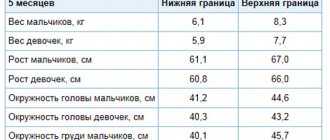Breastfed
There are several rules and recommendations that must be followed during breastfeeding.
How much milk does a breastfed newborn need?
The best option for feeding a newborn is breastfeeding. If there is enough of it, the baby can be content with it for the first 6 months (before the introduction of complementary foods). It is advisable to continue breastfeeding a newborn until 12 months (some breastfeed up to 1.5 years).
A child needs from 100 ml per day in the first days of life, up to 1/8 of the baby’s body weight per year.
After birth, lactation is small for a couple of days, but in the following days the amount of milk increases, and the baby can eat fully, especially since by that time he will have learned to suck well. It is not always clear to young parents how much a newborn should eat at one feeding.
You can suspect that a child does not have enough food based on the following signs:
- Cries constantly after feeding.
- The child is inhibited.
- Violent reaction to the approach of mother and her smell.
- Bad dream.
- Small amount of urine and rare bowel movements (normally there should be more than 12 urinations and stool after each feeding).
- Thumb or diaper sucking.
- Slow weight gain or loss (excluding natural weight loss in the first 3-5 days).
In this case, the newborn must be weighed several times after feeding before and after meals. The difference in weight in grams will show how much milk the newborn eats in one feeding and you can understand whether he is full.
First feeding
It is believed that the baby should be put to the breast within the first two days, but it is better if he receives the first feeding within an hour after birth. Then the mother will feed the baby at his first request if they are in the room together and every 1.5 hours if they are in different rooms. Normally, a baby gets enough milk from one breast at one feeding.
Milk standards in the first ten days
Mothers often wonder how much a newborn should eat at one feeding.
In the first days, the baby sucks weakly at the breast - his stomach is still small (maximum can hold 10 ml of milk). What is more important here is the frequency of feeding, which changes with age.
There are several ways to calculate how much milk a baby should eat per day up to 10 days of life.
For the first 10 days, the amount of food for an infant can be calculated using the following formula derived by Finkelstein:
Daily milk volume = 70 x n or 80 x n, where n is the serial number of the newborn’s day of life.
If a child was born weighing less than 3200 g, then the coefficient is taken equal to 70, if the child weighs more, the coefficient is equal to 80.
According to the formula of N.F. Filatov, the daily amount of milk is calculated as 2% of body weight.
Shkarin's method offers the following calculation formula:
- if the age is less than two months, then the volume of milk = 800 - 50(8-M), where N is the number of weeks of life;
- when the age is more than two months, the volume of milk = 800 + 50(M-2), where N is the number of months of the child.
N.P. Shabalov suggests that the norm of milk for a newborn per feeding is multiplying the day of life by body weight and by 3. Then multiplying the resulting number by the number of meals, we get the daily norm.
Basic rules: when and how best to feed a baby, how long to keep the baby at the breast
Modern pediatric doctors believe that a 1-month-old baby should not be fed strictly on time, but should be given breastfeeding when the baby is hungry and clearly wants to eat. Already a month-old baby sucks one breast normally from 15 to 40 minutes. You should not allow him to nurse for more than an hour.
A child at 2 months will already set his own feeding schedule according to time, and it will become easier for the mother to navigate.
Table of nutritional norms for up to a year
| Age in months | Milk norm for a newborn for 1 feeding in ml | Daily milk intake in ml |
| 1-3 day | 10-60 | 200-300 |
| 1/2 | 50-80 | 350-400 |
| 1 | 100-110 | 600 |
| 2 | 120-150 | 750-800 |
| 3 | 150-180 | 15-17% of body weight |
| 4 | 180-210 | 15-17% of body weight |
| 5-6 | 210-240 | 16% of body weight |
| 7-9 | 210-240 | 15% of body weight |
| 10-12 | 220-250 | 14% of body weight |
How do you know if your baby is not getting enough water?
There are some signs indicating a lack of fluid in the body.
They appear:
- In the lethargy and apathy of the baby.
- In dry mucous membranes.
- The fontanelle is sunken.
- For problems with urination (the daily norm is at least six times).
If you detect at least one of these symptoms, try to breastfeed your baby more often and give him some water each time between feedings (up to 20 ml at a time). Thanks to these manipulations, the water-salt balance in the baby’s body will be restored as soon as possible.
Artificially fed
Although breast milk is considered the best product for feeding a baby, there are situations when you have to switch to artificial nutrition. It may happen that the mother does not have milk or is sick, or, in rare cases, the baby cannot tolerate mother's milk. Then they resort to using cow's, goat's milk or, what is more acceptable, artificial mixtures with a composition close to human milk.
How to calculate the daily intake for artificial nutrition?
The daily dose is calculated in the same way as with natural feeding, but perhaps the single portion should be increased slightly, since most often artificial formula is given to the child a little less often, 8-10 times a day.
| Age in months | How much formula should a baby eat? |
| up to 1.5 | 1/5 of baby's weight |
| 1,5 — 4 | 1/6 baby's weight |
| 4-6 | 1/7 baby's weight |
| 6-8 | 1/8 baby's weight |
| 8-12 | 1/9 baby's weight |
Features of nutrition during artificial feeding
When feeding with special formulas, you must ensure that feeding is carried out at least 8 times a day, and that the child does not overeat, since it is much easier for him to get milk from the nipple than from the breast.
If the baby has eaten little at one feeding, then most likely he will add more food the next time.
A newborn is less likely to require food when bottle-fed, since formula or animal milk is digested much more slowly by him than mother's milk. It is best if you take a 6-hour night break in feeding, and make the interval between feedings 3 hours.
There is no need to urgently supplement your newborn's feeding if he wakes up shortly after eating and is crying. Perhaps he simply did not burp in time and is not comfortable. In this case, you need to hold him vertically against your shoulder and let him burp.
How can you tell if your child is full?
There are standard signs that indicate that the newborn is eating the required amount of food:
- calm behavior;
- deep sleep;
- sufficient weight gain every month;
- regular urination and bowel movements.
The main thing is to remember that each child is individual and requires appropriate treatment. Your little miracle knows better than anyone else when and how much it needs to eat. Be careful, be patient, and over time the feeding regime will improve itself.
Mixed feeding
Mixed feeding is when a mother breastfeeds her baby, but supplements her baby with artificial formula for some reason. Most often this happens when there is not enough milk or it is not fat enough. For children over six months of age, new foods are introduced into the diet, but breastfeeding is not stopped.
Supplementary feeding is carried out with adapted milk formulas. The same mixtures are suitable as for artificial nutrition, but your pediatrician will help you choose the best option.
The amount of mother's milk should be at least half of the diet; if it is less, the nutrition will become artificial.
There are two types of mixed feeding:
- The baby is first offered the breast, and then he drinks the formula. This method is preferable because it preserves good lactation.
- At different feedings, alternate formula and milk. That is, one product is given at one feeding, and another in the next feeding.
Supplementary feeding should be started with a small portion to check whether the formula is suitable for the baby.
How much formula does a mixed-fed baby need?
To find out how much milk a newborn should eat and how much formula per feeding, you need to carry out a control weighing after applying to the breast and determine how much is missing from the norm. This is how much it costs to give the mixture.
There is no need to supplement feeding until the baby has suckled from both breasts.
3 rules for supplementary feeding of children on SV
When feeding children, several rules should be followed:
- First they give both breasts, only then - supplementary feeding. In this way, the baby will receive as much natural food as possible, and lactation will last longer. This rule does not apply to medicinal mixtures that are usually given up to the breast.
- Supplemental feeding from a bottle is not recommended; the baby will not later take the breast due to the ease of obtaining milk from the nipple. The mixture is given from a spoon.
- At night it is more advisable to feed naturally. This will preserve lactation and is much easier for mom.
Review of popular mixtures
The modern baby food market offers a wide selection of products. We propose to consider the most popular of them.
Nutrilon
The product is produced in the Netherlands and imported from Russia. The food is used from birth to six months. The mixture is great for babies, helps get rid of colic, constipation and other digestive problems.
Feeding table
This table is used if there are no other instructions from the pediatrician.
Nan from Nestle
These products are manufactured by a Dutch company. The manufacturer offers a wide selection of mixtures for all ages. Their assortment is very large. It includes the following products:
- Nan 1 – intended for babies from birth to 6 months. It has all the necessary components for the formation of immunity and proper physiological development of the baby.
- Nan 2 – used from 6 months to a year. The composition is the same as in the previous version, but due to older age, the concentration of nutrients is increased.
- Nan 3 – recommended for use from a year. There are beneficial bacteria and other components necessary for children of this age.
- Nan 4 – used after reaching one and a half years. The composition is similar to Nan 3, but the concentration of nutrients is increased.
- Prepackaged milk in packaging. Recommended for children over 2 years old.
The choice of nutrition depends on the age and some other characteristics of the baby. Usually children eat this milk well, they like its taste.
In addition to regular mixtures, the Nan company produces medical nutrition. These are products such as Nan anti-colic, lactose-free, triple comfort, for premature babies.
Feeding table
When preparing food for a newborn, you need to carefully monitor the dosage of the powder, and also use sterilized containers.
Similac
Similac has a healthy and rich composition. It's easy for parents to choose the food that's best suited for their little one. The mixture does not contain dyes, palm oil, sugar or other harmful additives. The product is easily digestible by children and does not cause allergies. The company produces the following types of mixtures:
- Similac 1;
- Premium;
- Neoshur;
- Comfort;
- Hypoallergenic mixture and others.
Feeding table
If the baby drinks the specified amount of mixture per day, this is usually enough for him to feel good and be active throughout the day.
When choosing food for babies from birth or six-month-old toddlers, you should definitely consult a pediatrician.
Recommendations E.O. Komarovsky
- Feed with a nipple with a small hole to develop the sucking reflex and prevent overeating.
- Buy a hypoallergenic adapted mixture.
- Do not focus on sterilizing the bottle, just wash it well with hot water.
- Do not give vitamin D, there is enough of it in the mixture.
- Give water between feedings, 50 ml.
- Preference should be given to feeding by the hour.
- Break 3–4 hours;
- No need to wake up your baby to eat.
If there is a chance to stimulate breast milk, then there is no need to include artificial feeding of newborns before the age of six months, says E.O. Komarovsky. Despite the high quality of modern adapted mixtures, immunoglobulins and enzymes of natural milk cannot be replaced.











